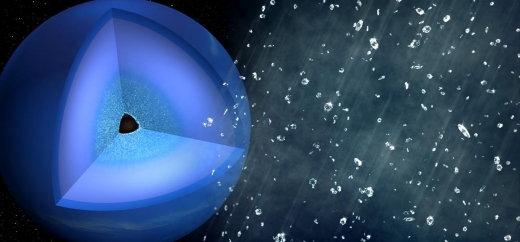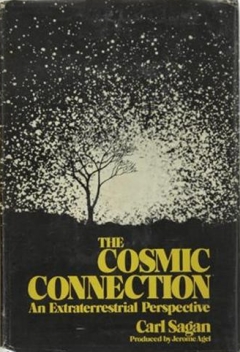Looking at recent headlines about ‘diamond rain’ on Neptune provoked a few thoughts about headline writers, though the image is certainly striking, but then I recalled that Carl Sagan used to enjoy pulling out the stops with language as much as anyone. Listen, for example, to the beginning of his 1973 title The Cosmic Connection:
There is a place with four suns in the sky — red, white, blue and yellow; two of them are so close together that they touch, and star-stuff flows between them.
I know of a world with a million moons.
I know of a sun the size of the Earth – and made of diamond.
There are atomic nuclei a mile across that rotate thirty times a second.
There are tiny grains between the stars, with the size and atomic composition of bacteria.
There are stars leaving the Milky Way. There are immense gas clouds falling into the Milky Way.
There are turbulent plasmas writhing with X- and gamma rays and mighty stellar explosions.
There are, perhaps, places outside our universe.
And so on. The Cosmic Connection was long on language and imagination, and in its day, ideal for bringing the findings of astrophysics to the attention of the general public. Back in 1973, when I wasn’t poring over medieval texts, I kept the book nearby and re-read various chapters, enjoying Sagan’s effusive enthusiasm. I can see him adding a line or two about the latest findings on the interior of ice giants like Neptune and Uranus, with his own poetic twist.
And diamonds raining down from a high-pressure ‘sky’ deep in Neptune’s atmosphere to the dark core beneath certainly create a striking image. They’re suggested by a new paper looking at the chemical processes going on inside such worlds, which has demonstrated a way of creating what the researchers call ‘nano-diamonds,’ carbon atoms compacted into useful objects we may one day use in everything from medical procedures to industrial cutting needs. Nano-diamonds are likely paralleled by much larger diamonds in planetary interiors.
Having a magical image translated into practical science — and with real-world applications to boot — makes this story the kind of attention-grabber Sagan would have loved. The work involves an international team led by Dominik Kraus (Helmholtz Zentrum Dresden-Rossendorf), with experiments taking place at the SLAC National Accelerator Laboratory in Menlo Park, CA.

Image: By conducting experiments at the Linac Coherent Light Source — one of the world’s most powerful X-ray lasers — an international team of researchers led by HZDR physicist Dr. Dominik Kraus was able to demonstrate that hydrocarbon compounds split into carbon and hydrogen inside ice giants such as Neptune, shown here. The carbon turns into a “diamond shower.” Credit: Greg Stewart / SLAC National Accelerator Laboratory.
The ice giants of our outer system – and doubtless in other systems – contain solid cores thought to be surrounded by different ices — hydrogen molecules connected to lighter elements. What Kraus and colleagues wanted to do was to simulate the environment 8000 kilometers down, where high pressure produces diamonds that fall as precipitation deep into the interior.
The environment inside an ice giant was simulated by creating shockwaves in plastic using an optical laser beam at the Matter in Extreme Conditions (MEC) instrument at SLAC’s Linac Coherent Light Source (LCLS). Carbon atoms in the original plastic emerged as part of nanometer-scale diamond structures. On Uranus or Neptune, the researchers believe, such diamonds would be considerably larger and would eventually sink to the planet’s core.
The polystyrene used in the experiments is made from a mixture of hydrogen and carbon, and is used to simulate compounds formed from the methane that gives Neptune its distinctive color. Deep below the clouds of the ice giants, methane forms carbon and hydrogen chains that respond to the high pressure further down by forming the kind of diamond rain observed.
At SLAC, the optical laser created pairs of shock waves in the plastic which, when overlapping, produced the pressure needed to form the diamonds. At this point, the reaction could be probed with 50 femtosecond X-ray pulses from the LCLS, a kind of X-ray snapshot of the reaction.
“For this experiment, we had LCLS, the brightest X-ray source in the world,” said Siegfried Glenzer, professor of photon science at SLAC and a co-author of the paper. “You need these intense, fast pulses of X-rays to unambiguously see the structure of these diamonds, because they are only formed in the laboratory for such a very short time.”
The phenomenon is fascinating enough on our own ice giants, but the work has interesting implications for exoplanets because better models of planetary interiors can change the way we evaluate the relationship between mass and radius. The researchers believe the infall of diamond rain could also prove to be an additional heat source as it approaches the core.
The SLAC work goes beyond earlier attempts to simulate the formation of diamonds in ice giants by capturing measurements in real time, a feat made possible here through the combination of the optical lasers at MEC combined with X-ray pulses from the LCLS. We wind up with a glimpse of high-pressure diamond formation that agrees with theory and gives us further insight into the conditions inside planets like these. And conceivably, the clumping behavior of matter observed in this and other matter compression studies could give us better insight into the fusion of forms of hydrogen into helium, a process we’ve yet to master.
Sagan’s diamond star? “Some white dwarfs are largely carbon,” he writes in The Cosmic Connection. “We may speak of a star made of diamond.” Not quite the same phenomenon as a rain of diamonds on Neptune, though he does go on to quote Bob Dylan’s “To dance beneath the diamond sky / With one hand waving free,” a poetic stretch we can still enjoy whether it’s raining or not.
The paper is Kraus et al., “Formation of diamonds in laser-compressed hydrocarbons at planetary interior conditions,” published online by Nature Astronomy, 21 August 2017 (abstract).




Back around 1975 when I turned 13, I finally discovered the joy of reading (as opposed to just flipping through books on space to look at pictures and read captions or just a paragraph or two). The first books I started ravenously reading were paperback collections of Asimov’s science fact essays… first about astronomy then physics then everything else. It was about this same time that I got my first book by Carl Sagan – “The Cosmic Connection”. I inhaled this book during the summer of 1975 and it affected my thinking about science on so many levels. I still have that same paperback copy in my library along with a shelf full of other Sagan and Asimov paperbacks which collectively set me down the road of science (and writing!) I still travel today… one of these days, when I get some time, I will have to pick up “The Cosmic Connection” and read it again :-)
You and me both! I remember loaning my copy all over the place to try to get people as excited about the book as I was. Loved every word.
Oh…. I MUST get a copy!!!!
I just referenced your wonderful blog, Mr. Gilster, on the Disqus Sci-fi “channel,” a sort of sub-Reddit that I just discovered. Those guys need a little hard science mixed in with the movie reviews, etc.
Thanks for reminding us about Sagan’s poetic bent.
Very kind of you, Scooter!
The initial thing I can recall that caught my attention when I first read The Cosmic Connection was an artist representation of the Venera 8 probe on the surface of Venus. In the days before the Internet et al combined with Soviet secrecy regarding space, seeing a detailed diagram of a Soviet Venus lander – from an original Soviet source, no less – was amazing.
http://mentallandscape.com/V_Lavochkin1.htm
That Sagan made certain to include it in his book was part of his overall effort to get the two main contenders in the Cold War to set aside their warlike ways and work together in peace through space. He also tried this by promoting a joint American-Soviet manned mission to Mars in the 1980s.
http://articles.chicagotribune.com/1988-07-26/news/8801170893_1_mars-goal-human-crews-manned-mission
I found the image of the Venera 8 lander artwork that was in the book, though this is the original version with everything labeled in Russian:
https://pbs.twimg.com/media/B46Ih2pCIAAbX-4.png
Venera 8 was the last of the generation of Soviet Venus landers going back at least to Venera 3 in 1966.
Bought the paperback edition of The Cosmic Connection at my local magazine stand/drug store in 1975 for $1.75. I still have it on my bookshelf. It was printed on good paper and is in suprisingly good condtion. It was my first of many Sagan books.
Back then Sagan used to get a lot of grief from the academic community for popularizing science ( a proper scientist shoudn’t waste his time writing to the masses) and also for his interest in exobiolgy ( a proper astronomer should study stars, not little green men on undiscovered planets). My gut feeling back then was he was right and they were wrong. Turns out he was ahead of his time.
My how times have changed for the better! Planets everywhere in the galaxy (“billions and billions”) and the main focus for NASA is the search for life in the universe. And science popularizers are celebrated now not derided.
Will have to read the Cosmic Connection again.
Sagan knew from the beginning that if you do not get the general public interested in science, not only will you not have future scientists, you won’t get funding and other vital support as well. That became apparent to scientists and engineers once the Cold War money started to go away.